Text

A Burgonet with a wonderful grotesque Buffe,
Height: 10.6 in/27 cm
Width: 9.3 in/23.5 cm
Depth: 11.2 in/28.5 cm
Weight: 5.3 lbs/2.3 kg
Germany, ca. 1540-1550, housed at the Kunsthistorischesmuseum, Veinna.
#armor#armour#helmet#burgonet#europe#european#germany#german#hre#holy roman empire#renaissance#khm#art#history
767 notes
·
View notes
Text

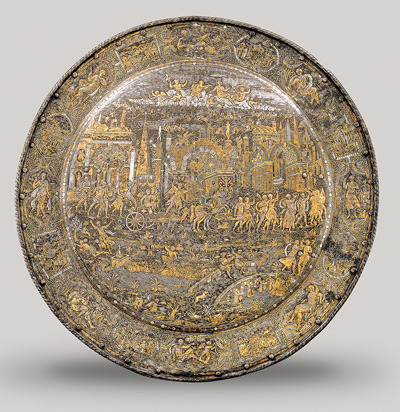
1) Burgonet of Philip II, Northern Italy, c. 1560–1565
Medium: gold- and silver-damascened steel, fabric
⠀
2) Shield, Milan, c. 1565–1570
Medium: gold- and silver-damascened steel, leather, fabric
⠀
Ancient wars were a popular subject for Renaissance parade armor, as on this shield and burgonet depicting scenes from the Trojan War.
⠀
The left side of the helmet shows the Judgment of Paris, the Trojan prince who declared Aphrodite the most beautiful goddess after she promised him Helen, wife of the king of Sparta.
⠀
On the right side, Trojans tear down part of their city walls to make way for the huge Trojan horse in which Greek warriors were hidden. Paris’ abduction of Helen and the Greeks’ departure for Troy appear in the center of the shield.
⠀
🏛 Patrimonio Nacional, Real Armería, Madrid
⠀
- -
1) Бургиньот Филиппа II, Северная Италия, ок. 1560–1565 гг.
Материалы: Сталь, дамаскирование золотом и серебром, ткань.
⠀
2) Щит, Милан, ок. 1565–1570 гг.
Материалы: Сталь, дамаскирование золотом и серебром, кожа, ткань.
⠀
Древние войны были популярной темой для парадных доспехов эпохи Возрождения, как на этом щите и бургиньоте: сюжет со сценами Троянской войны.
На левой стороне шлема изображен Суд Париса, троянского принца, объявившего Афродиту самой прекрасной богиней после того, как она пообещала ему Елену, жену царя Спарты.
⠀
На правой стороне - троянцы сносят часть городских стен, чтобы освободить место для огромного троянского коня, в котором прятались греческие воины. Похищение Парисом Елены и уход греков в Трою изображены в центре щита.
⠀
🏛 Королевская Оружейная палата в Мадриде
⠀
#armsandarmor #medievalarmour #armour #knight #armor #armure #harnisch #harness #armatura #armadura #Burgonet #Philip_II #Бургиньот #Филипп_II #Shield #щит
#medieval#средневековье#middleages#history#armor#armours#история#harnisch#armadura#armour#бургиньот#burgonet
48 notes
·
View notes
Text

Burgonet - Filippo Negroli (Italian, Milan, ca. 1510–1579)
"This masterpiece of Renaissance metalwork is signed on the browplate by Filippo Negroli, whose embossed armor was praised by sixteenth-century writers as “miraculous" and deserving “immortal merit." Formed of one plate of steel and patinated to look like bronze, the bowl is raised in high relief with motifs inspired by classical art. The graceful mermaidlike siren forming the helmet’s comb holds a grimacing head of Medusa by the hair. The sides of the helmet are covered with acanthus scrolls inhabited by putti, a motif ultimately derived from ancient Roman sculpture and wall paintings."
3 notes
·
View notes
Text
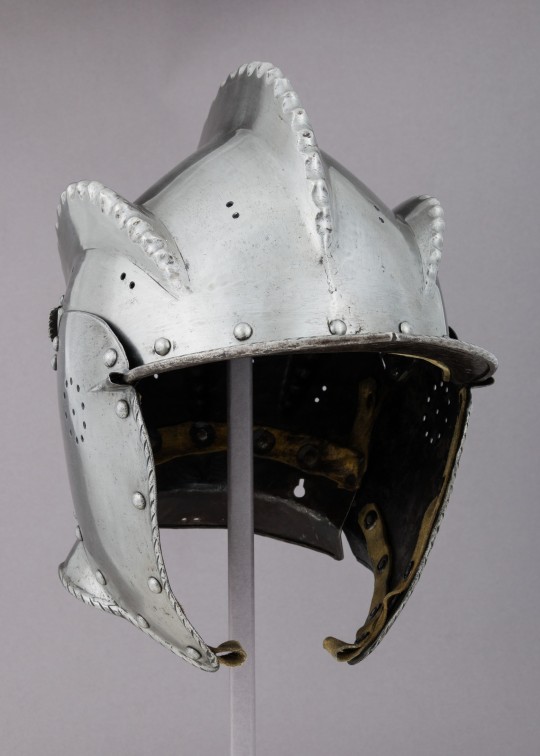

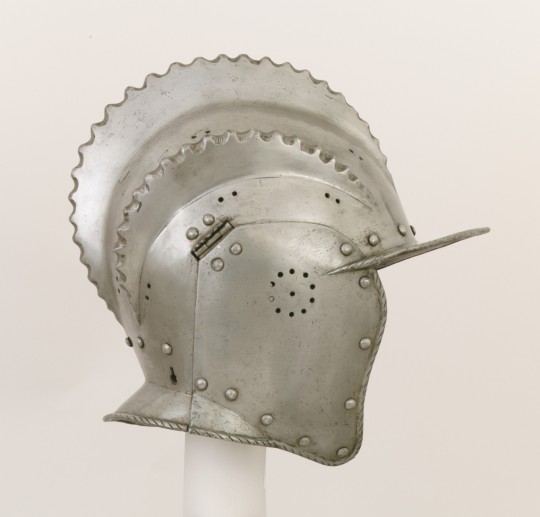
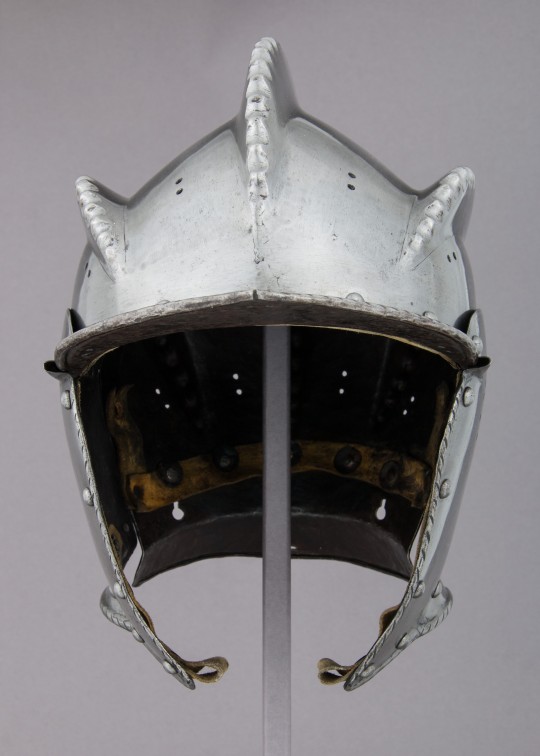
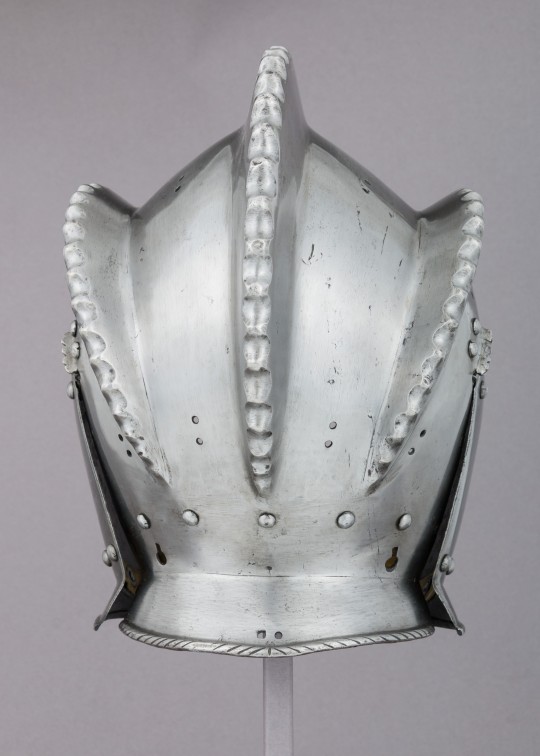
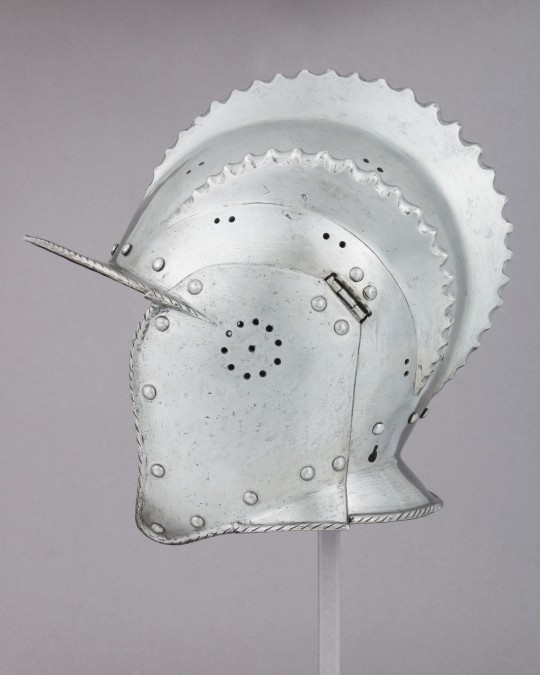

Triple-Combed Burgonet
Title: Burgonet Armorer: Replacement cheek-pieces made by Leonard Heinrich (American (born Germany) Munich 1900–1966 Clarksville, New Jersey) , in The Metropolitan Museum of Art, Armor Workshop Armorer: Replacement cheek-pieced made in The Metropolitan Museum of Art, Armor Workshop Date: ca. 1540–50; cheekpieces replaced, 1932 Geography: Augsburg Culture: German, Augsburg Medium: Steel, leather Dimensions: H. 11 7/8 in. (30.2 cm); W. 8 1/8 in. (20.6 cm); D. 12 in. (30.5 cm); Wt. 4 lb. 15 oz. (2251 g) Classification: Helmets
This burgonet belongs to a series of virtually identical examples having three raised and engrailed combs that were worn by the guards attached to a noble German or Austrian house. Several helmets bear the mark of Augsburg and that of Desiderius Helmschmid (1513–1579), the city's leading armorer in this period (this particular helmet is unmarked). Pairs of holes in the bowl suggest that the surface was covered with fabric, stitched in place, leaving only the tall combs exposed. The forging of a helmet bowl with three tall combs from a single plate of steel required considerable skill; the challenge was also met by Italian armorers, who created triple-combed burgonets for the Farnese guard (see acc. no. 04.3.219). (The cheekpieces are modern replacements made by the Museum's armorer Leonard Heinrich in 1932.)
1 note
·
View note
Photo
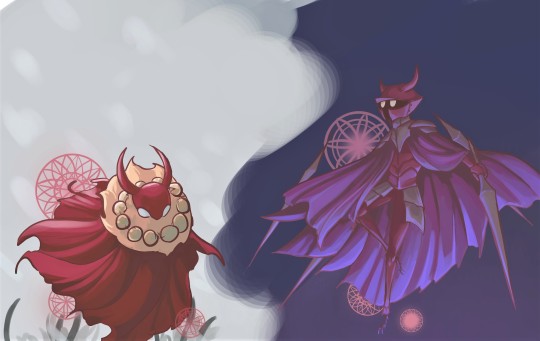
trying to figure out what my art style is and stuff so have these two dorks
#hollow knight#hollow knight xero#hollow knight markoth#im tired but theres so much i wanna do :(#abyssdoodl#also yes i gave xero a burgonet thing because i was struggling to draw his helmet
331 notes
·
View notes
Text
omgomg everybody look at this burgonet helmet its SO cute

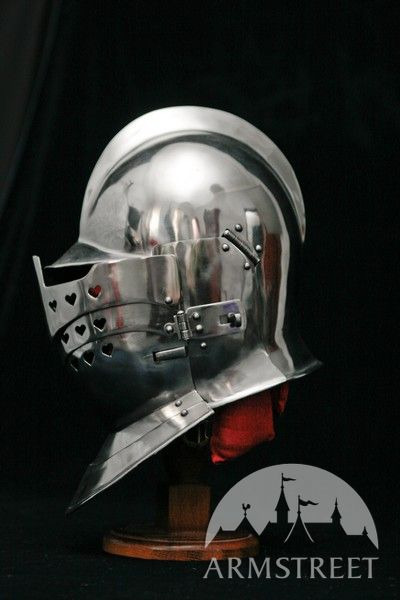
it's frm this website (its not available tho)
#incoherent turtle noises#i love burgonets in general i think theyre cute but my god........ lovecore knight........#cant believe i just found out abt this site... hehehee easy reference material get!!!#i Just made the realisation that there are stores that sell medieval stuff and i can use those images For Reference.#like yeah obviously. and yet.#ok but theres this one bascinet w/ an absolutely GORGEOUS visor that im just like. houghh... like i Want that. cant afford any of this obvs
89 notes
·
View notes
Text

Etched burgonet and breastplate, Northern Italy, circa 1550-1600
from The Cleveland Museum of Art
184 notes
·
View notes
Text
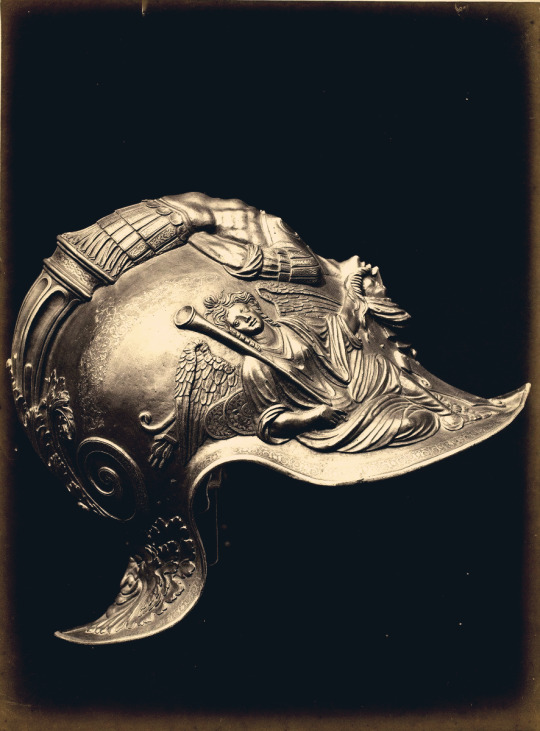
Burgonet of Charles V. Photography Jane Clifford, circa 1865.
#dark aesthetic#dark art#dark#renaissance#15th century#goth aesthetic#dark academia#dark academism#darkest academia#dark photography#19th century photography#holy roman empire#holy roman emperor
86 notes
·
View notes
Text
The interior art for the 8th edition Warhammer Fantasy Empire army book is so good.

The skull attached to the cap, worn over a skull cap.
The eye patch with Sigmar's Comet on it
The oversized pistol, with the comet and the skull.
The griffin's head worn over the shoulders.
The fluted Maximillian-esque armour.
The helmet (going to assume burgonet) with the lion/dragon's face on it with the laurel wreath.
The hourglass worn over the armour.
I'm pretty sure it's a Dave Gallagher piece.
21 notes
·
View notes
Text
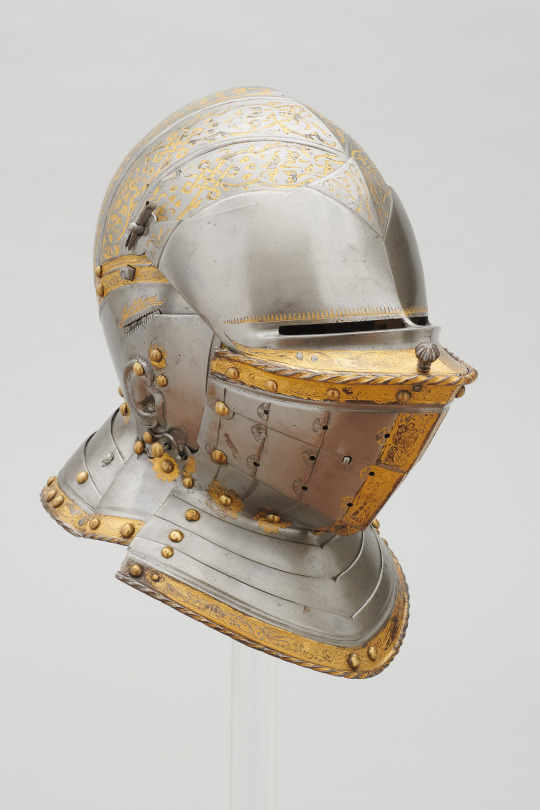
A closed Burgonet with a removeable visor made for Holy Roman Emperor Charles V, attributed to Desiderius Helmschmid,
Height: 12.4 in/31.5 cm
Width: 9.1 in/23 cm
Depth: 12.2 in/31 cm
Weight: 5.3 lbs/2.4 kg
Augsburg, Germany, ca. 1535-1540, housed at the Kunsthistorischesumuseum, Vienna.
#armor#armour#helmet#burgonet#europe#european#germany#german#augsburg#hre#holy roman empire#renaissance#khm#art#history
712 notes
·
View notes
Text
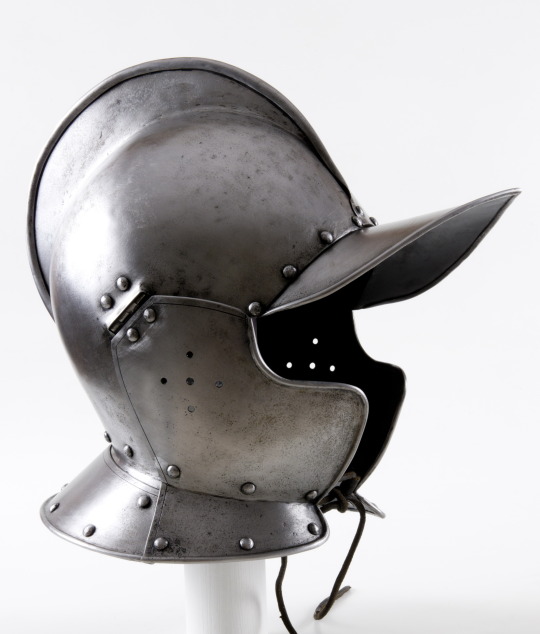

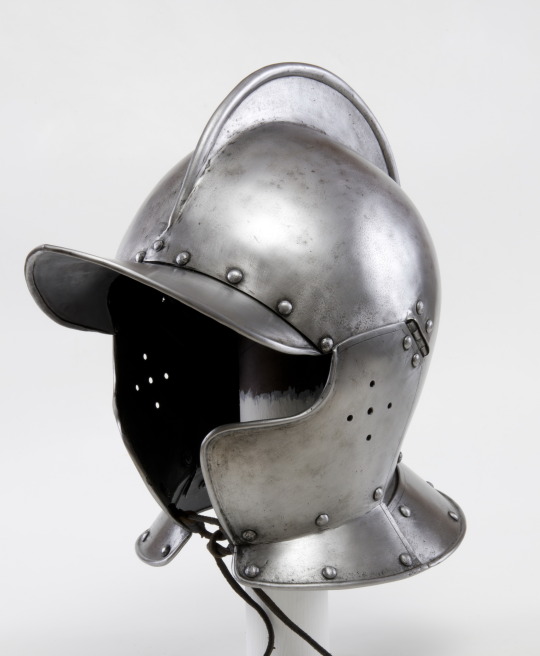
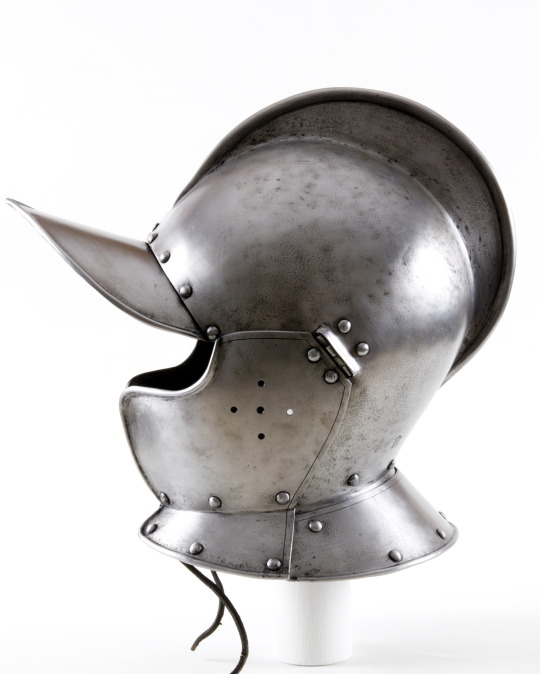
⚜ Reconstruction of a helmet of the "Bourguignot" type, mid-second half of the XVI century. Medium: iron, leather Technique: forging, surface aging Made in 2015 by our Creative workshop "Steel Legacy"
More photos on the website 👉 http://sl-armours.com/en/gallery-of-medieval-arms-and-armour/helmets/160.html
Ph. by V. Sibrikov
⚜ Реконструкция шлема типа "Бургиньот", середина—вторая половина XVI в. Материалы: железо, кожа; Техника: ковка, состаривание поверхности; Изготовлен в 2015 году в нашей Художественной мастерской "Стальное Наследие".
Больше фото на сайте 👉 http://sl-armours.com/ru/gallery-of-medieval-arms-and-armour/helmets/160.html
Фото: В. Сибриков
#steellegacy#стальноенаследие#medieval#средневековье#middleages#history#armor#armadura#armours#история#harnisch#armour#orderarmor#armororder#доспехиназаказ#доспехи на заказ#medievalarmour#helmet#burgonet#бургиньот#шлем
33 notes
·
View notes
Text
What is an Almain Rivet ?

An Almain rivet is a suit of European armor made en masse in the late 15th and 16th century to equip foot soldiers. The word Almain is derived from the Alemanni tribe, the name of which is used in French and old English to call German people. Rivet in this context is derived from the use of rivets to link the articulated sliding plates covering the thighs and shoulders of the wearer, and came to be used to refer to the entire suit of armor.


Almain rivets in storage at the Styrian armory in Austria.
These plate harnesses were often made of iron and produced in large numbers at little cost to equip the new armies of the early Renaissance, based on professional standing armies wearing standardized equipment for specific roles. They consisted of a breastplate and back plate, articulated tassets and spaulders and a gorget. It was usually coupled with an open faced helmet like a cabasset, morion or burgonet.
200 notes
·
View notes
Note
Greetings! What, in your esteemed opinion, is the worst (functional/protective) helmet to have ever existed?
Hark! There is no one helmet which is the unequivocal worst! The fields of combat shift over time, and therefore the requirements for helmets art also fluid! However...
I appreciate your clarification on "function and protection". That, aye, I can answer that.
There are many helmets which fit into the same class of poor protection. You see, often we think of helmets such as great helms for the helms of white armor when we consider the idea of a helmet. However! This design was only used for a short time, and for a considerable portion of that short time it was used exclusively in sport! Both before and after such Closed faced helmets, there have been many helms which were meant for more inexpensive warriors who were facing less brutal blades. These helmets would often forgo facial covering and would focus on the top and sides of the face. Helmets like these are the ones most commonly used today! This is because the benefits of facial coverings (protection from blunt and mildly piercing blows) no longer outweigh the trade-offs (reduced visibility, increased weight etc.) Some of these helms include early bassinets, burgonets, cervellieres, dragoon helmets, and modern day military caps.
However! I know what thou seeks... you seek... THY JUICY TAKES! AND TO THEE I SHALL PROVIDE!
To preface, I apologise to my friends who have stated their propensity for the following piece of armor. However! The Frog Mouth helmet is one of the most specialised pieces of Closed face helmets, and is accordingly the least suited for general use! The Frog Mouth helmet is descended directly from the Great Helm, which similarly had a very thing ocularia. The thing that makes the Frog Mouth particularly ineffective in comparison, however, is that it takes on an increase in weight, a decrease in visibility and a decrease in mobility in exchange for high excellence in jousting use. So, in the act of jousting, hurrah for frog mouth! However, in terms of general use and practicality, tis not the greatest of them all!
There! Thy Hot GOSS! Served!
Hurrah for preventing concussions, hurrah!
#not an officiation#inquiries#knight#armor#hurrah oh hurrah!#helmet#ps. most info sourced from wikipedia
7 notes
·
View notes
Text
#knightcore#tumblr polls#thought i'd do this for fun and also to help me decide something for real#also im by no means a history expert on this im just mentioning helmet names i know
28 notes
·
View notes
Text

Etched burgonet and breastplate, northern Italy, 16th century
from The Cleveland Museum of Art
276 notes
·
View notes
Text
World building and theories of Engage
Introduction to Brodia
Brodia
The name Brodia could have been inspired by Clan Brodie, a Scottish clan whose origins are uncertain due to historic records being destroyed. Clan Brodie was involved in several clan conflicts and were covenanters during the civil war. The home of Clan Brodie was Brodie Castle in Moray, Scotland. Their emblem is a right hand holding three arrows.
The emblem of Brodia is a crown above a helmet with two crossed swords. It is based on a Scottish crest. The crest is the helmet and the coronet sits above it. The helmet is based on the burgonet which was the main helmet used in 16th century Scotland. It was referred to as the 'steel bonnet' by Scotland's enemies. The helmet is facing forward which is a symbol of royalty in heraldry. Behide The helmet are two crossed swords which are based on claymores. In heraldry the sword is a symbol of military honour, liberty and strength. It was a two handed, basket hilted weapon which was used between the 15th to 17th century. Finally the crown sits at the top of the crest. In heraldry the crown is a symbol of sovereignty, victory and empire.
Brodia gains its wealth by military expansion and mining. The Kingdom is also described as having a robust fishing industry.
Brodia is known as The Kingdom of Might. This could possibly be inspired by 'The Mighty Scots Guard' who are an infantry regiment known for their discipline and courage in battle. "Strong of Body, Strong of Heart" is the battle cry of the Brodian's In Scotland each clan has a unique battle cry. Clan Brodie's battle cry is "Unite."
At the start of the game Brodia is at war with Elusia.
The environment is said to be rugged and rocky.
5 notes
·
View notes